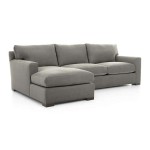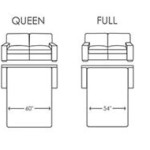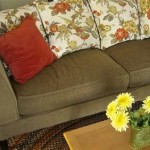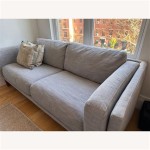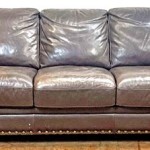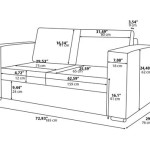The Indispensable Sofa: Anchoring the Living Room
The sofa, often the largest and most utilized piece of furniture, serves as the cornerstone of the living room. It’s more than just a place to sit; it’s a focal point for design, a hub for social interaction, and a personal sanctuary for relaxation. Understanding the multifaceted role of the sofa is crucial when designing or redesigning a living space.
The selection process for a sofa involves careful consideration of size, style, material, and functionality. These elements must coalesce to create a cohesive and comfortable environment that reflects the inhabitants’ lifestyle and aesthetic preferences. The chosen sofa should seamlessly integrate with the existing décor or, conversely, serve as the starting point for a new design scheme.
The placement of the sofa within the living room significantly impacts the flow of the space and its overall usability. Whether positioned against a wall, floating in the center of the room, or used to define separate zones, the sofa's location dictates how the room is navigated and used. Thoughtful planning is essential to maximize both visual appeal and practical functionality.
Sofa Style and Design Considerations
The market offers a plethora of sofa styles, each with its own distinct characteristics and suitability for different living spaces. From the classic Chesterfield with its tufted upholstery and rolled arms to the sleek and minimalist Lawson sofa, the options are extensive. Understanding the nuances of each style is essential for making an informed decision.
The Chesterfield sofa, for instance, projects a sense of traditional elegance and is well-suited for formal living rooms or studies. Its deep button tufting and luxurious leather upholstery create a timeless and sophisticated aesthetic. However, its larger dimensions may not be ideal for smaller spaces.
The Lawson sofa, characterized by its clean lines and comfortable cushions, offers a more versatile option. Its simplicity allows it to blend seamlessly with a variety of decorating styles, from modern to transitional. The Lawson sofa’s customizable cushions and upholstery options make it a popular choice for those seeking both comfort and style.
Sectional sofas, composed of multiple modular pieces, provide maximum flexibility and seating capacity. They are particularly well-suited for larger living rooms or entertainment spaces, allowing for customizable configurations to accommodate different needs. Sectionals can be arranged in various formations, such as L-shapes, U-shapes, or even as individual chairs and ottomans.
Beyond these classic styles, numerous other options exist, including sleeper sofas, which offer additional sleeping space for guests, and loveseats, which are ideal for smaller apartments or as supplementary seating in larger living rooms. The key is to select a style that complements the overall design aesthetic and caters to the specific needs of the household.
Upholstery plays a critical role in the overall look and feel of the sofa. Fabric choices range from durable and stain-resistant microfiber to luxurious and supple leather. Each material offers its own set of advantages and disadvantages in terms of aesthetics, durability, and maintenance.
Leather sofas, known for their durability and timeless appeal, require regular conditioning to prevent cracking and maintain their suppleness. Fabric sofas, on the other hand, offer a wider range of colors and patterns, but may be more susceptible to stains and wear and tear. The choice of upholstery should be based on lifestyle considerations, such as the presence of children or pets, as well as personal preferences.
Optimizing Sofa Placement and Room Layout
Strategic sofa placement can dramatically impact the perceived size and flow of a living room. In smaller spaces, positioning the sofa against a wall can create a sense of openness and maximize floor space. In larger rooms, a floating sofa arrangement can help to define separate zones, such as a conversation area and a reading nook.
Consider the focal point of the room when determining sofa placement. If the room features a fireplace or a large window with a scenic view, the sofa should be positioned to take advantage of these focal points. Conversely, the sofa can serve as the focal point itself, drawing attention and anchoring the space.
Traffic flow is another critical factor to consider. The sofa should be positioned in a way that allows for easy movement around the room, without creating obstacles or bottlenecks. Ensure that there is ample space between the sofa and other pieces of furniture, such as coffee tables and end tables.
The height of the coffee table should be approximately the same height as the sofa cushions, allowing for comfortable access to drinks and snacks. End tables should be positioned within easy reach of the arms of the sofa, providing a convenient surface for lamps, books, and other essentials.
Rugs can be used to visually anchor the sofa and the surrounding furniture, creating a cohesive and inviting space. The rug should be large enough to accommodate at least the front legs of the sofa, and ideally extend beyond the edges of the furniture.
Lighting plays a crucial role in enhancing the functionality and ambiance of the living room. Layered lighting, consisting of ambient, task, and accent lighting, can create a warm and inviting atmosphere. Table lamps positioned on end tables provide task lighting for reading or other activities, while floor lamps can provide ambient lighting to illuminate the entire room. Accent lighting, such as spotlights or sconces, can be used to highlight artwork or architectural features.
Accessories, such as throw pillows and blankets, can add color, texture, and personality to the sofa. Choose pillows and blankets that complement the overall color scheme and style of the room. Consider using a variety of sizes and shapes to create visual interest. Seasonal changes can also be reflected in the accessories used, creating a refreshed look and feel.
Functionality and Practical Considerations
Beyond aesthetics, the functionality of the sofa is paramount. Consider the primary uses of the living room and the needs of the household when selecting a sofa. If the room is frequently used for entertaining, a large sectional sofa with ample seating capacity may be the best option. If the room is primarily used for relaxation and watching television, a comfortable and supportive sofa with reclining features may be more suitable.
The construction of the sofa is a key indicator of its durability and longevity. Look for sofas with a solid hardwood frame, sturdy legs, and well-constructed joints. Avoid sofas with particleboard or flimsy frames, as they are less likely to withstand heavy use.
The cushions should be made of high-density foam or a combination of foam and feathers. High-density foam cushions provide firm support and retain their shape over time. Feather-filled cushions offer a more luxurious and comfortable feel, but require more frequent fluffing to maintain their shape.
Consider the ease of cleaning and maintenance when selecting a sofa. Fabrics that are stain-resistant and easy to clean are ideal for households with children or pets. Leather sofas can be easily wiped down with a damp cloth, while fabric sofas may require professional cleaning.
Sofa dimensions are important, especially for smaller living spaces. Measure the available space carefully before purchasing a sofa to ensure that it will fit comfortably without overwhelming the room. Pay attention to the depth of the sofa, as this can significantly impact the amount of floorspace it consumes.
Some sofas come with additional features, such as built-in storage compartments or USB charging ports. These features can enhance the functionality of the sofa and make it even more convenient to use. Consider these options if they align with your needs and preferences.
The height of the sofa back is another factor to consider. A higher sofa back provides more support for the head and neck, while a lower sofa back offers a more streamlined and modern look. The ideal height will depend on personal preferences and the desired level of support.
The sofa's arm style also contributes to its overall comfort and aesthetics. Rolled arms offer a classic and elegant look, while track arms provide a more modern and minimalist aesthetic. Consider the arm style that best complements the overall design of the room.
In conclusion, selecting the right sofa for the living room requires careful consideration of style, placement, and functionality. The sofa acts as the centerpiece of the room, impacting both its visual appeal and its usability. By understanding the various factors involved in the selection process, individuals can choose a sofa that perfectly complements their lifestyle and enhances the overall living experience.

Grey Sofa For Living Room Design Ideas Designcafe

11 Best Couches And Sofas To Buy 2024 The Strategist

Tayyaba Enterprises Modern Beautiful Design Wooden L Shape Sofa For Living Room Couch Home

Wooden Velvet Modern Living Room Sofa Set Cushion Back U Shape

Best Sofa Design Add Glamour With Ideas By Livspace

10 Best Black Sofas For A Dramatic Look Sofa Living Room Small Decor
:max_bytes(150000):strip_icc()/101-9718e7f4f82b4c3bbfbb7b68303e3347.jpeg?strip=all)
23 Living Room Ideas With Gray Couches
.jpg?strip=all)
Our Living Room Reveal With Article Dream Green Diy

Modern Sofa For A Living Room

Brown Sofa Living Room Ideas For Your Home Designcafe

